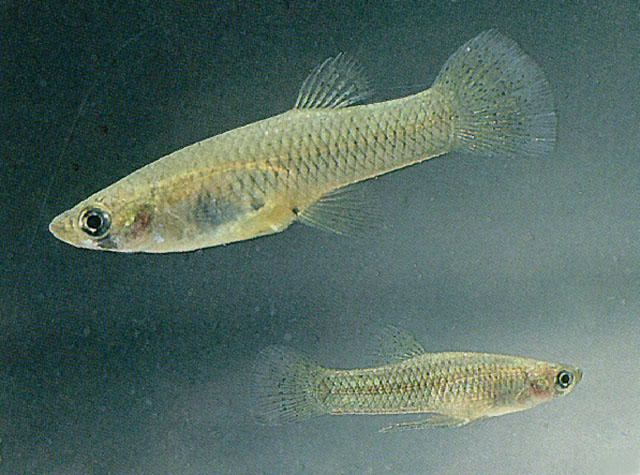| Poeciliidae (Poeciliids), subfamily: Poeciliinae |
| 5.1 cm TL (male/unsexed); 7 cm TL (female); max. reported age: 3 years |
|
benthopelagic; freshwater; brackish; pH range: 6 - 8; dH range: 5 - 19, potamodromous |
| North and Central America: Mississippi River basin from central Indiana and Illinois in USA south to Gulf of Mexico and Gulf Slope drainages west to Mexico. One of the species with the widest range of introductions which acquired for itself a near pan-global distribution (Ref. 1739). Several countries report adverse ecological impact after introduction. |
|
Dorsal spines (total): 0-0; Dorsal soft rays (total): 7-9; Anal spines: 0-0; Anal soft rays: 9-10. Origin of dorsal fin opposite 7th anal ray. Length of anal base much less than half distance from caudal. 8 horizontal scale rows between back and abdomen. Ventrals terminate immediately before anal fin. Pelvic fins reach ventrals. |
| Most abundant in lower reaches of streams (Ref. 44091). Adults inhabit standing to slow-flowing water; most common in vegetated ponds and lakes, backwaters and quiet pools of streams. Found frequently in brackish water (Ref. 5258). Pelagic and surface predatory fish (Ref. 94816). Feed on zooplankton, small insects and detritus (Ref. 5258, 10294). Used as live food for carnivorous aquarium fishes. Viviparous (Ref. 5258, 30578). Effective in mosquito control and widely introduced, but found to compete with indigenous fish and to upset the ecological balance (Ref. 6351). |
|
Least Concern (LC); Date assessed: 22 January 2019 Ref. (130435)
|
| potential pest |
Source and more info: www.fishbase.org. For personal, classroom, and other internal use only. Not for publication.
